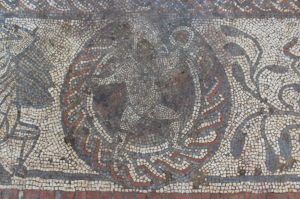A unique ancient Roman mosaic depicting such mythological figures like Bellerophon, Pegasus, the Chimaera, Hercules, centaurs, and Cupid was unearthed in Boxford, West Berkshire, United Kingdom.

Archaeologists believe that the 1600-year-old Roman mosaic might be the most exciting mosaic discovery made in Britain in the last 50 years. It is 6 metres long, showing a range and combination of images that have not been seen on a Roman mosaic in the UK before. It is believed that the art-piece dates to 380, the last decades of Roman rule in Britain. The mosaic has been discovered on the site of a Romano-British villa of a rather medium size, which is unusual. The site was gradually being excavated for a short period each summer since 2011 by the local historians at the Boxford History Project, volunteers from the Berkshire Archaeological Research Group and the commercial firm Cotswolds Archaeology.

It is reported that the central scene depicts a hero from Greek mythology, Bellerophon riding on the winged horse Pegasus as he attacks the Chimaera, a fire-breathing monster with the head of a lion, torso of a goat and rear of a dragon. It is believed that this myth later was converted by Christians into the tale of St George and the Dragon. The mosaic also has inscriptions, which is rare. They have not been deciphered yet, but might elate to the central compartments, which show scenes from Bellerophon’s life. Another scene shows a man wearing a lion skin, possibly Hercules, fighting a centaur with a club, which is unique as there are no other definite examples of a centaur in mosaics from Roman Britain.

In the centre of the mosaic, a person is show, believed to be King Iobates seated centrally, offering his daughter Philonoe on the left to Bellerophon on the right as a reward for killing the Chimaera and succeeding in a number of other tasks. Researchers state that this scene is rarely depicted in mosaic and no Romano-British examples are known. On other part of the mosaic Cupid sits in a round frame holding a wreath thought to represent one of the seasons. In the corners, the mythical figures of Telamon, giants and Atlas extend from their frames in a way not normally seen in Roman mosaics. Some of the figures’ lower legs morph into snakes curling up alongside them.

(after Sky News, International Business Times & Cotswold Archaeology)
Permalink //
Amazing!! Rare and exciting. Hope to see it insitu.